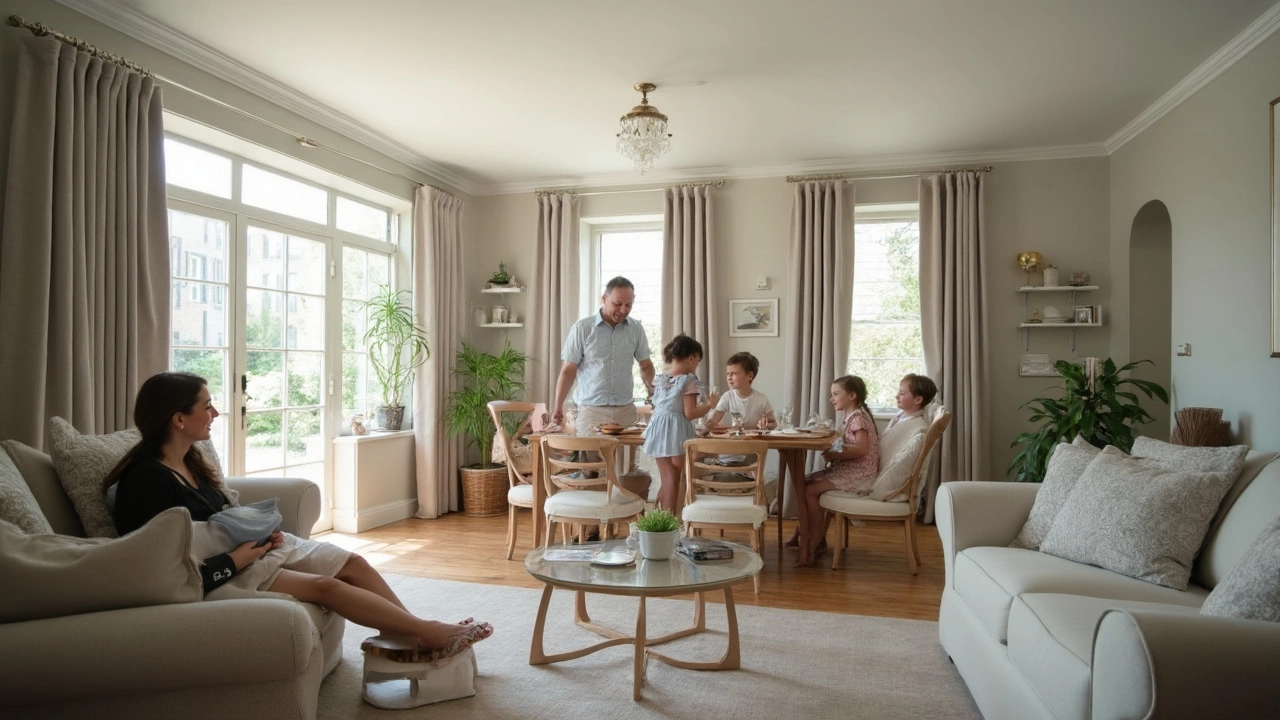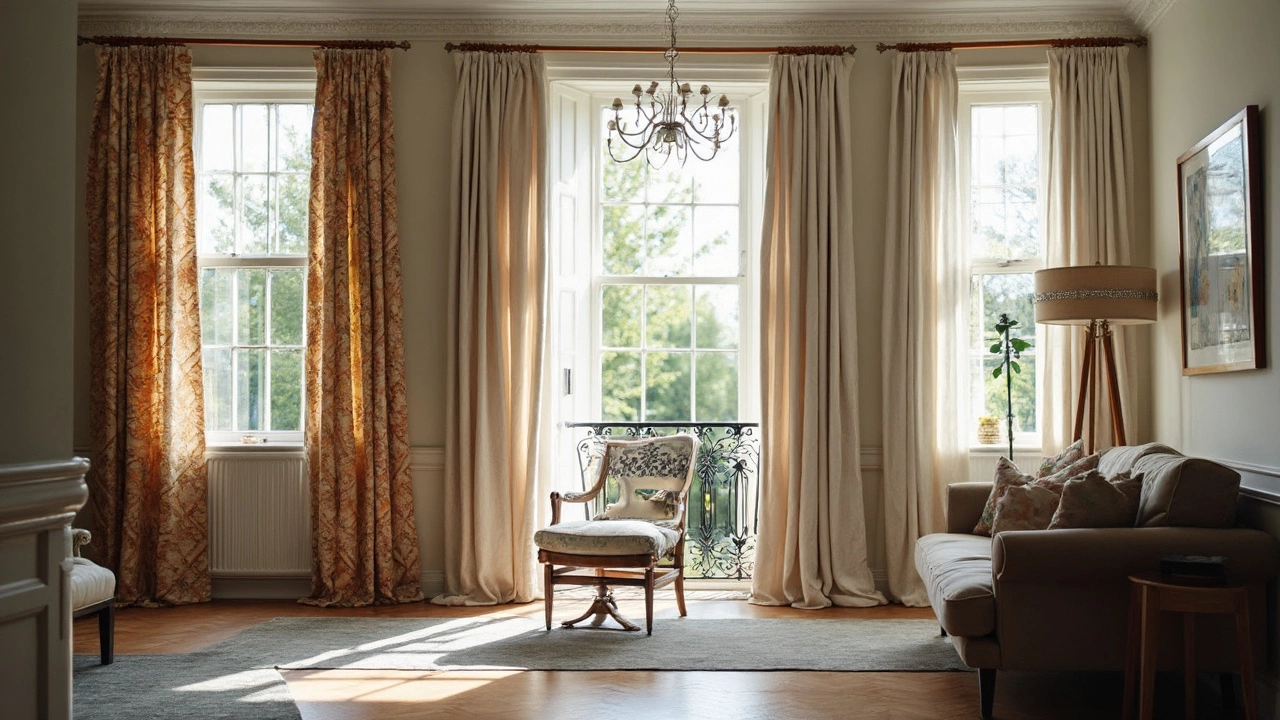Thinking about putting the same curtains in every room? You’re definitely not alone. Lately, I've noticed a lot more people picking one curtain style and just running with it everywhere—bedrooms, living rooms, even kitchens. On paper, it sounds pretty simple. Fewer decisions, less shopping, no guessing about color schemes.
But is it really the magic shortcut to a cozy, stylish home? The answer isn’t a simple yes or no. Your personality, how you use your rooms, and even how much sunlight sneaks in all play a part. Some folks want a house that flows—like when you walk into a hotel and every room just feels like it fits together. Others like each space to have its own vibe.
Before you buy six packs of the same beige curtains, there are a few things you should seriously think about. Will you get tired of looking at the same pattern everywhere? What about rooms that need blackout curtains versus ones that deserve light, breezy sheers?
Let’s get into the real pros and cons, and explore how you can nail a look you won’t regret the moment the box arrives. Trust me, I’ve made both safe choices and bold ones—and yes, Maxwell still brings up the neon pink experiment in the guest room. So grab that coffee and let's sort out if going uniform is right for you.
- Why People Use the Same Curtains Everywhere
- The Perks of Uniform Curtains
- Where It Can Go Wrong
- Mixing and Matching: Smart Ways
- Making the Best Choice for Your Home
Why People Use the Same Curtains Everywhere
Nothing makes life easier than sticking with just one style of curtains in your whole home. Shopping is a breeze—just figure out what you want and buy enough for every window. If you’re busy or just want to keep things simple, this approach knocks hours off your to-do list.
Bigger reason? It’s all about that “matching” look. Some people love when every room feels connected. When your home decor matches from room to room, it creates a consistent vibe, which can actually make smaller houses feel a bit bigger and tidier. Interior designers sometimes suggest this for open-concept layouts, so spaces flow and don’t feel choppy.
Cost is another big one. Buying the same curtain ideas in bulk means you might score a discount—some stores even offer better prices or throw in a free panel if you buy more at once. Here’s a quick comparison between single-style and mixed-style costs, based on real 2024 prices for popular retailers:
| Curtain Buying Style | Average Cost per Window | Bulk Discount |
|---|---|---|
| Same Curtains (bulk) | $30 | Up to 20% off |
| Different Curtains (individual) | $38 | None |
Don’t forget about easy cleaning. When every curtain is the same, you can just throw them all in one wash, and you won’t worry about one fading faster than the others. Plus, if you ever need to replace a panel, you know exactly what to look for.
At the end of the day, a single curtain style just takes out the guesswork. It covers a lot of the stress people feel when picking out interior design stuff. If you want your space to feel “put together” without spending hours scrolling online, this method just makes sense.
The Perks of Uniform Curtains
Here’s the honest truth—going with the same curtains in every room is downright practical, and it’s more common than you might think. First, it makes the whole shopping game so much easier. Pick a style you love once, measure everything in one shot, and boom—you’re done. No need to switch between swatches or risk getting lost in a maze of choices at the store.
If you’ve ever walked into a home where all the windows rock the same look, there’s this instant sense of home decor flow. Everything feels pulled together, which is super slick if you’re gunning for that modern, minimalist vibe. Realtors actually talk about this flow thing a lot, especially when selling or renting. A tidy, unified look can make a place feel bigger and more expensive. Want your small apartment to seem just a touch more upscale? Uniform curtains can help you cheat that a bit.
Cleaning? Way easier. One set of matching curtains means one set of washing instructions. No surprises if you need to toss them in the machine. Plus, if one gets stained, you can usually swap it with a less-noticed window and no one’s the wiser. If you like low-maintenance, it’s a no-brainer.
Another big perk: scoring a deal. You can often save real money buying curtains in bulk. Many stores will give you a discount for bigger orders, and you don’t end up with leftover fabric or weird mismatched singles lying around taking up space. Just look at this recent price comparison:
| Curtain Brand | Cost Per Panel (Single Buy) | Bulk Order (6+ Panels) |
|---|---|---|
| EasyHome Linen | $30 | $24 |
| ModernNest Cotton | $45 | $37 |
Oh, and let’s talk peace of mind for a second. Rooms facing different directions often get different sunlight. When you use all the same curtains, you’re less likely to end up with one sun-faded panel standing out like a sore thumb. With uniform curtains, replacement is simple—you know what to look for, and you’re not stuck with something discontinued or impossible to match years down the line.
Honestly, using the same curtains everywhere is like putting your home on cruise control for style. If consistency is your jam or you just don’t want surprises, it’s a safe, smart move.

Where It Can Go Wrong
Okay, so having the same curtains in every room might sound easy—but honestly, sometimes it just flops. Here's where things can head south. First, not all rooms in your home do the same job. Your kitchen usually needs something that’s easy to wash and stands up to cooking odors. Bedrooms, though, need blackout strength for good sleep, while a living room might beg for softer, natural light. Using identical curtains for both can leave one or more spaces totally mismatched for what they need.
Another thing most people don’t consider? Different rooms get different amounts of sunlight. In a south-facing room, light linens can fade super fast, while in a dim north-facing home office, thick heavy curtains can turn it into a cave. That’s not fun when you’re trying to work or read.
Design-wise, too much matching gets old quickly. Walk into a house with the same print on every window, and it’s like déjà vu in every room. Instead of feeling stylish, your home can end up looking bland or, worse, like an old-school motel. Even stats from home staging firms suggest buyers are 45% more likely to remember homes with bold, varied window treatments compared to those with a cookie-cutter look. It’s simple: our brains crave a little change from room to room.
Here’s a quick list of common problems people run into:
- Functional mismatch (bedrooms need dark, kitchens want wipe-clean)
- Sun fading (light fabrics suffer quickly in sunny spaces)
- Style fatigue (it starts to look boring, fast)
- Resale impact (potential buyers might not vibe with the uniform look)
- Practical issues (some rooms might be oddly sized and standard curtains won’t fit right everywhere)
The easiest way to avoid these headaches? Pay attention to what you really need in each room. Curtain ideas work best when they're practical and personal. Don’t be afraid to let each space breathe a little different.
Mixing and Matching: Smart Ways
If the idea of the same curtains in every room makes you hesitant, you’re not stuck with an all-or-nothing approach. Many decorators actually recommend mixing and matching curtain styles to add more personality and function where it counts most. You don’t need a design degree to pull this off, but you do need a game plan.
Start simple: pick one main color that shows up in every room but change up the fabric or pattern. For example, a navy curtain in the living room can be mirrored with navy-and-white stripes in the kitchen. The result ties your space together without making it look like copy-paste from room to room.
- Functional needs: Blackout panels for bedrooms, sheers for sunrooms, and stain-resistant options for dining areas make way more sense than forcing one curtain to do everything.
- Patterns and solids: If one room has bold patterns, keep the connecting room’s curtains solid for balance. Too much effort? Even using the same pattern in different colors gives a unified feel.
- Lining and hardware: Curtain rods and rings can match across the house, while the panel styles can shift. This keeps things coordinated, without feeling too matchy-matchy.
According to interior designer Jessica Geller of Toledo Geller,
"Mixing curtain fabrics lets you customize the mood and function of each room, but using one element in common—like rod color or curtain length—brings the whole home together."
Want a quick way to see what works? Take a look at the fabric content and light-blocking percentage on the product label. Some fabrics filter more sun than others—a polyester sheer will look totally different than a heavy velvet blackout. Here’s a quick stat for you:
| Room | Typical Curtain Type | Purpose |
|---|---|---|
| Bedroom | Blackout | Block light and keep privacy |
| Living Room | Sheer or Semi-sheer | Let in natural light |
| Kitchen | Cafe or Valance | Easy to clean, let in daylight |
Swapping styles like this means you get both function and style, which is the sweet spot in home decor. Just remember, the magic comes from finding something in common, not forced uniformity. That could be a metal finish, fabric texture, or a single color family. And don’t be afraid to try out a few sample panels side-by-side before you go all in. Your house, your rules.

Making the Best Choice for Your Home
This is where things get real. Picking the right curtains for each room isn’t just about style—it's also about how you live. Every home is different, so what worked for your neighbor or your favorite designer on Instagram might not be perfect for you.
First off, ask yourself: what’s the room used for? Bedroom? You’ll probably want blackout or lined curtains to keep that early morning sun from blasting you awake. But in the dining area or kitchen, you might prefer lighter, airier fabrics to keep things bright and fresh.
If you’re leaning toward using the same curtains everywhere, it helps if all your rooms get similar amounts of daylight and are roughly the same size. Otherwise, the same fabric can look totally different depending on the space. For example, what looks soft and cozy in a small den could end up feeling heavy in a bigger, sunnier living room.
Here are a few tips for making the best call for your place:
- Measure Every Window: Double-check every single one. I’ve been burned by assuming every window was identical, only to end up with panels three inches too short in the kids’ room.
- Think Function First: Does the room need privacy? Blackout? Easy washing because toddlers, pets, or—like Maxwell—mysterious spaghetti incidents?
- Test Swatches: Borrow or order samples and pin them up. Check them in different light, at different times of the day.
- Stay Open-Minded: You might start out wanting everything matching, then realize mixing a few patterns or textures makes your place feel more “you.”
One study from Houzz reveals over 65% of homeowners say they want their home design to "reflect their personality and lifestyle"—not just look like a catalog. That’s a good reminder to do what fits you, not just what’s everywhere online.
Don’t just take my word for it. Here’s what renowned interior designer Sarah Richardson once said:
"Curtains set the tone for a room, but that tone doesn’t have to be the same in every space. Listen to each room’s energy and let it guide you."
If you’re a data person, here’s a quick snapshot I found helpful:
| Room | Preferred Curtain Type | Common Fabric Choice |
|---|---|---|
| Living Room | Light Filtering | Linen, Cotton Blend |
| Bedroom | Blackout | Velvet, Polyester |
| Kitchen | Sheers/Café | Cotton, Polyester |
The bottom line? There aren’t any strict rules. It’s about what feels good for you—looks, function, and how your family actually lives. No need to stress about making the “right” call. If you get stuck, start small with one room and see how it feels. You can always swap things up if something doesn’t sit right once everything’s hanging. Trust your gut—and enjoy watching your home come together.


